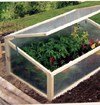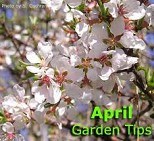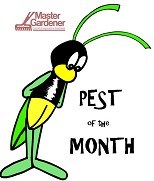 The CCEFM master gardeners plan and create a large exhibit annually in the Cooperative Extension building at Fonda Fair.
 A CCE master gardener is a teacher. Sometimes it is one-on-one and ...
 Sometimes it is a group of youth in a school or at Fonda Fair...
 And sometimes it is in classroom before a large group of people.
 CCEFM master gardeners hold a plant sale annually and dispense information about selection, planting and care of plants they sell.
|
Posted 9/24/2013
 Interested in becoming a volunteer master gardener for Cornell Cooperative Extension in Fulton and Montgomery Counties? The Cornell Cooperative Extension (CCE) Master Gardener Volunteer (MGV) programs are managed individually by county CCE associations. Volunteer training occurs at different intervals for each county. Core horticulture training is the first requirement of the CCE Master Gardener Volunteer commitment and this is done through the completion of a 45 hour (10 week) CCE Master Gardener Volunteer Training course in general horticulture. The cost for the training is $125. This is followed by an agreement to volunteer at CCEFM, attend monthly Master Gardener meetings and complete 100 additional hours of training within two years. After the initial 100 hours CCEFM will refund $25 of your cost. Once you stop volunteering you are no longer a master gardener as it is not a certificate program.
For more information on what a master gardener does, when the upcoming trainings are or for more information view the attached brochure or call the CCE office at 518-673-5525.
Posted 8/6/2013
 Cornell Cooperative Extension Master Gardener Barbara Henry will highlight what you need to do to get your garden ready for the winter in a workshop on Wednesday, September 4th, 2013 from 6:00pm -8:00pm at the Shirley Luck Senior Citizen Center (109 East Main St. Johnstown).
- Learn what to do with your annuals, summer bulbs and containers as well as your lawns and autumn leaves that cover them.
- Learn how to handle your perennials, how to deal with early frosts in your vegetable gardens, and what steps to take to prepare your garden beds for next year.
The cost is $5.00 per person payable at on-site registration, interested individuals must pre-register on or before August 28, 2013 by calling 518-673-5525. See the attached flyer for more information.
Posted 7/18/2013
 Deadheading is a death warrant of a sort -- for seeds, that is. It sounds vicious, but it is also a potentially rewarding garden practice: Promptly removing spent flowers prevents a plant from reproducing. The frustrated plant will then frantically race to procreate, producing more and more flowers, trying to set seeds.
Getting the Most from your Plants:
Deadheading -- picking off spent flowers, young seedpods, or fruit -- encourages plants to bloom over a longer time than they normally would, or to produce bigger and better flowers or fruit so that the resulting seeds will be of the best possible quality. Since the plants are prevented from devoting energy to excess seed production, the flowering and production period is extended and long-term flower quality is enhanced as well.
This explains why fruit trees naturally drop overloaded fruit and why gardeners disbud peonies and hard-prune hybrid tea roses to create show-quality blooms. It also explains why you need to pick peas and beans almost daily -- or the plant will stop producing. It explains why the more cute little zucchinis you pick the more you get (for better or worse.) And it explains why deadheading and cutting back bloomed-out flowers can seem to rejuvenate the plants. Eventually the plants may become exhausted, but in general they comply because their mission in life is to grow, bloom, set seed, and take over the world.
Coneflowers Take Over:
Which brings us to purple coneflowers (Echinacea purpurea), deadheading, and averting a homegrown population explosion. Because coneflowers, it seems, are bent on taking over the world one seed at a time -- sneaky little devils.
Not that they aren't great flowers. 'Magnus' was named 1998 perennial of the year for good reason. Purple coneflower plants are big and bold, just like their flowers. They rarely need staking, watering or coddling of any sort. They just grow and bloom their heads off. And their profusion of purply-pink daisy-type flowers lures in droves of butterflies. And birds, if the coneflower seed heads are left standing in the garden all winter.
Therein lies the problem. These plants ask only a well-drained spot in the sun. Where they're happy, you may find them colonizing new ground at a rapid pace and out-competing their plant neighbors. The solution to this is deadheading before all those seeds get scattered. But what to do when garden order and wildlife benefit are at odds? Try planting a small patch of coneflowers in an out-of the-way corner of the garden to provide seeds for the birds; then deadhead the plants sharing space in more cultivated borders and beds. This way, both you and the birds will be happy!
Posted 7/18/2013
 With the recent floods and heavy rains many gardens have been flooded. There are many precautions that need to take place which include what vegetables/fruits need to be disguarded, what to do with the soil etc. Below are several tips from the South Dakota CCE office.
-
Soil from gardens, including unplanted gardens, that were recently flooded may not be safe for fruit and vegetables production.
-
Floodwaters may contain contaminants such as agricultural or other chemicals, as well as disease-causing organisms from fresh manure, septic systems, and even lagoons.
-
Following flooding, any leafy greens that are eaten fresh, such as lettuce or cabbage, should be destroyed. They are at risk of contamination for 90 days following a flood.
-
Leafy greens that will be cooked, such as spinach, should be cut back completely and allowed to re-grow before using. Cook them thoroughly before using.
-
Remove the blossom or set fruit from strawberry plants exposed to floodwaters. Any strawberries from these plants that are consumed within the next 90 days should be cooked before consuming.
-
Root crops should be peeled and cooked thoroughly.
-
For peas, beans, squash, or tomatoes, if their fruit is present during flooding, the fruit should be picked and discarded. Any of these vegetables that contact the ground during the 3 months following the flood should be either discarded or peeled and thoroughly cooked. Underground vegetables such as carrots and potatoes should also be peeled and thoroughly cooked. Thoroughly wash produce with thick outer rinds, such as melons and squash, before cutting open.
View the entire document below in the attachment for more useful tips!
Posted 7/10/2013
 Careful, you can do more harm than good. Most lawns in New York rarely need watering, except possibly for a few weeks in summer. Foregoing watering during these weeks does not mean that you can’t still maintain a healthy tufr, but it does mean careful preparation before this period of moisture stress.
If you do choose to water, it’s important that you water properly. Poor watering practices can do more harm to your lawn than good and it can carry pollutants out of your yard and into waterways.
Never water at night. The best time to water is early in the morning, between 4:00 a.m. and 8:00 a.m. Evaporation is low at this time so more of the water makes it into the soil. Also, leaves will begin drying quickly in the morning sun reducing the chances of diseases. Avoid watering on cloudy days. To learn more about how much water your lawn needs and more useful tips view the document below.
Posted 6/12/2013

Have the Best Annuals Ever by Following These Steps:
- Prepare the soil by cleaning out all the weeds and adding organic matter.
- Purchase annuals without flowers so that you can enjoy the blooms longer. Choose shorter bushy plants because the larger ones are more established already and may not transplant as well. If you do buy plants that have flowers already, pinch them off to encourage the plant to develop good roots first. Pinching out the first flowers will also result in bushier plants.
- A dark green color is generally a good indicator of a strong healthy plant. (Make sure that they are not light colored or yellowing. Nor should they have brown patches)
- Plant to the depth they were in the six packs and water them in thoroughly. Go back the next day and water again. Do not rush to plant them outside, wait until the night time temperatures are in the 50Fs. Remember that our last frost date in Fulton County is around the last week in May. Cool weather annuals such as alyssum and pansies can be set out earlier but impatiens will sulk if put out too soon and they may not recover.
- Keep up with watering, plants usually need about one inch of water a week but those in containers may need to be watered daily or even more than once a day.
***For more tips read the entire article below ***
Posted 5/8/2013
by Phyllis Minich
 Many of the most helpful garden creatures are the most underappreciated. Worms, turtles, moths, moles, dragonflies, snakes, toads, bats, wasps and spiders are all very helpful 'wild' things that can inhabit our yards and gardens if we back off on the harsh lawn chemicals and poisonous insecticides we use.
Let’s start at the bottom, worms are so basic to the health of our soils most of us don’t give them a thought, but without them we would have reduced soil fertility, and much less aeration. All the holes worms create and the ‘castings’ they produce add to our soils health without much work from us. If you want to help them do their job you can add organic matter to the soil. Good soil is the basis for good gardening!
Turtles, snakes, moles and toads all help us in the garden by eating bugs and small rodents. Harmful insects make up 62% of a toads diet. Most snakes are harmless. They eat small rodents and some insects. Moles eat their body weight in insects, slugs and grubs everyday and they aerate the soil. And turtles consume slugs and snails. Wouldn’t it be fun for the kids to find a turtle in the garden? We can help them do what they do by providing a bit of cover for them to hide in, try stacking a few rock and or some wood in a secluded spot.
Flying critters can be big helpers in the landscape, too. Dragonflies and bats both can eat hundreds of mosquitoes every day. Yum. Of course birds are beautiful and hard working. Many are insect eaters and are a good indicator of your gardens health. If you have birds, bees and butterflies in your yard chances are your environment is supporting a large variety of living things. You can help them by providing native plants and a bit of clean water.
I’ve saved the most underappreciated garden helper for last, the spider. Many people are just plain afraid of them but as with many other creatures most are harmless and can be quite helpful. Spiders are able to consume many of the predator pests that do so much damage to our plants. If you are afraid of spiders or any other wild thing outside in your garden, just give it a wide berth, they are just as afraid of you!
And just to be on the safe side wear gloves and perhaps a long sleeve shirt and long pants while working in the areas that have the most potential for ticks and other biting insects.
Posted 5/2/2013
 Looking to build a cold frame and/or hotbed for your plants? Cold frames and hot beds are miniature greenhouses perfect for starting your plants this spring. A cold frame is a bottomless box covered with a light-admitting lid. Sun enters the box during the day heating the soil and air inside, at night the soil radiates the heat absorbed during the day back into the covered frame. Hot beds are similiar to cold frames, except that in addition to the sun's heat, they use an artificial means of heating the soil-usually an electric cable.
Hot beds and cold frames should always be located on well-drained soil, free from flooding during heavy rains. A southern exposure is desirable to make maximum use of limited light. For more information on exactly how to build a cold frame or how to operate them view the attached document.
Posted 4/24/2013
 Are you interested in gardening but your space is limited? Try growing plants in containers. This class will demonstrate how you can grow vegetables for your table and enhance your deck or entranceway with flowers grown in containers. Participants will learn how to choose your container and plants, design the container and maintain a mini-garden throughout the season. Each participant will plant a container garden of their own to take home. All materials will be supplied.
Join master gardeners Mary Ann Charon and Jean Sweet on Thursday, June 6th from 6-8 p.m. at the Shirley Luck Senior Citizen (109 East Main St. Johnstown, NY). Cost is $10 and all materials are supplied. Register with the Cornell Cooperative Extension office at 518-673-5525 by May 30th.
Posted 4/18/2013
 Vegetable growers and flower gardeners alike will find quality-stock plants at the annual Master Gardener Plant Sale sponsored by Cornell Cooperative Extension in Fulton and Montgomery Counties. The sale will be held in the parking lot of Udderly Delicious, North Comrie Avenue (State Highway 30A) in Johnstown on Saturday, June 1, 8:30 – 11:30 a.m. A wide variety of vegetable bedding plants, including several varieties of tomatoes, annuals and perennial flower plants, and some house plants will be featured in this year’s sale.
Home-owners who wish to spruce up their grounds in preparation for backyard celebrations, add some color to their landscapes, fill some window boxes or patio planters, or just plant a flower garden, will find beautiful color and selection. Volunteer master gardeners will be on site to help individuals make selections to plant together into containers or directly into the landscape.
A major goal of the plant sale is to provide one-on-one expertise on-the-spot to local customers. “This plant sale is a unique experience because there are trained volunteer master gardeners who can answer your questions about preparing your space and planting the plants to help you be successful with the plants you decide to buy,” according to master gardener Deb Landrio.
Questions about the sale may be directed to Cornell Cooperative Extension in Fulton and Montgomery Counties at 518-673-5525 x 101. Proceeds from the sale will augment learning opportunities for the Fulton/Montgomery Master Gardener Program.
|

The Cornell Cooperative Extension Master Gardener Program provides direct support for home gardeners by answering questions on the phone, email, and at events, teaching classes, and identifying insects. These volunteers stay current on horticultural topics.

Tip #1:
Consider planting flowers which may be dried for winter arrangements. Some of the best are strawflower, statice, celosia, and globe amaranth.
Tip #2:
Do not restrict yourself to buying plants in bloom. Petunias that bloom in the pack are often rootbound or overgrown and, after planting, will actually be set back and cease to bloom for about a month. Plants without blossoms will actually bloom sooner and will grow better as well.
Tip #3:
To extend the blooming period of gladiolus, plant early, middle and late season selections each week until the middle of June. Choose a sunny location and plant the corms four to six inches deep and six to eight inches apart.
Tip #4:
When chrysanthemums show signs of life, dig up and divide large plants. Discard woody portions and replant divisions 12 to 15 inches apart.
Tip #5:
Cut flower stalks back to the ground on daffodils, hyacinths, and other spring flowering bulbs as the flowers fade. Do not cut the foliage until it dies naturally. The leaves are necessary to produce strong bulbs capable of reflowering.
Tip #6:
The last Friday in April is National Arbor Day. Plant a tree, or support an organization which does.
Tip #7:
Prune spring blooming shrubs such as forsythia and spirea after they have completed flowering.
Do you have a gardening question for the Master Gardener in Fulton or Montgomery Counties?
Send an email! A trained volunteer master gardener will get back to you as soon as possible.
mastergardenerccefm@cornell.edu
You may also leave a message on their voicemail:
518-853-2135

It's time to scout for Japanese beetles. Evidence suggests that adult beetles are attracted to previously damaged leaves. Therefore reducing feeding damage now can result in less feeding damage in the future.
Japanese beetle adults are one quarter to one half inch long with copper colored wing covers and a shiny metallic green head. Kind of attractive in a buggy sort of way. A key characteristic is prominent white tufts of hair along their sides.
They also have the munchies for your favorite rose, linden, grape, raspberry and some 350 different plants. They generally do not feed on dogwood, forsythia, holly, lilac, evergreens and hosta. To view more information on identifying Japanese beatles and how to control/get rid of them view the article below.
 Download File Download File
|















